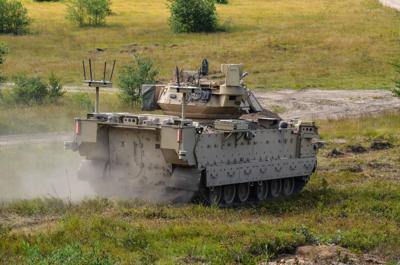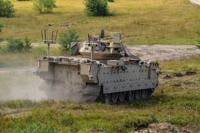The Army is rolling out its robot tanks at Fort Carson, and at this stage, they’re really old.
The service is stepping into the future this month with war games at Fort Carson that test the teaming of manned armored vehicles with drone tanks. But rather than spending a few billion dollars to buy new robotanks, the Army is using “modified M113 tracked armored personnel carriers, known as Robotic Combat Vehicle.”
The M113 has its origins in a Pentagon program pushed by the Eisenhower administration and is being phased out of use by the Army.
Unlike science fiction, where robots fully take over the battlefield and eventually the planet, these robots are meant to augment but not replace soldiers in combat.
“The purpose of the robotic combat vehicles program is to develop a suite of vehicles that can be remotely operated to do two things: provide additional time and space for leaders to make decisions by providing additional reconnaissance capabilities and standoff distance; or to replace Soldiers in high risk activities like combined arms breaches or chemical, biological, radiological, nuclear, and explosives reconnaissance,” according to the Army.
The robots being tested by the post’s 3rd Brigade Combat Team are never far from human controllers, much like the Air Force’s drones fight with a human pulling the trigger electronically.
At Fort Carson, the robotic tanks are controlled by soldiers riding in specially-equipped M-2 Bradley Fighting Vehicles.
The Army in recent years has led the world in development of integrating robots with people on the battlefield. The service’s Gray Eagle drones can be controlled by crews of Apache attack helicopters allowing a small unit to control a bigger battlefield and allowing a robot to take on the riskiest missions.
That has long been the mantra as the Army has developed its future doctrine incorporating robots on the battlefield. The purpose of the machines is to save lives in combat by making them take on some of the most dangerous tasks.
And, while the Army hasn’t purchased its first robotic tanks, the war games at Fort Carson provide a crucial first step.
During the drills, officials can see how soldiers and robots work together, and what technological shortcomings will have to be overcome to make the system work.
Reliable, if elderly, the M-113 robots are perfect for the job. They’re already mechanically sound, so the main concern for troops will be worrying about the technological end of things.
Getting to the next step quickly is what is really crucial for the Army. Most of the equipment in the Army inventory was due for replacement 20 years ago. But after 9/11, programs for new tanks and guns were shelved as the military battled in Iraq and Afghanistan.
So the Army remains equipped for the Cold War in vehicles that have been nominally adapted to the electronic battlefield.
That pause in developing new weapons for the Army gave time for rivals such as Russia and China to match U.S. technology, cutting American advantages in battle. Without a technology leap like the one that is being tested at Fort Carson, the Army could find itself outmatched in future fights.
“Ultimately, this program is about giving soldiers additional tools to make them successful in a complex, and multi-domain battlefield,” the Army said.
Contact Tom Roeder: 636-0240 Twitter: @xroederx





 Your Privacy Choices
Your Privacy Choices